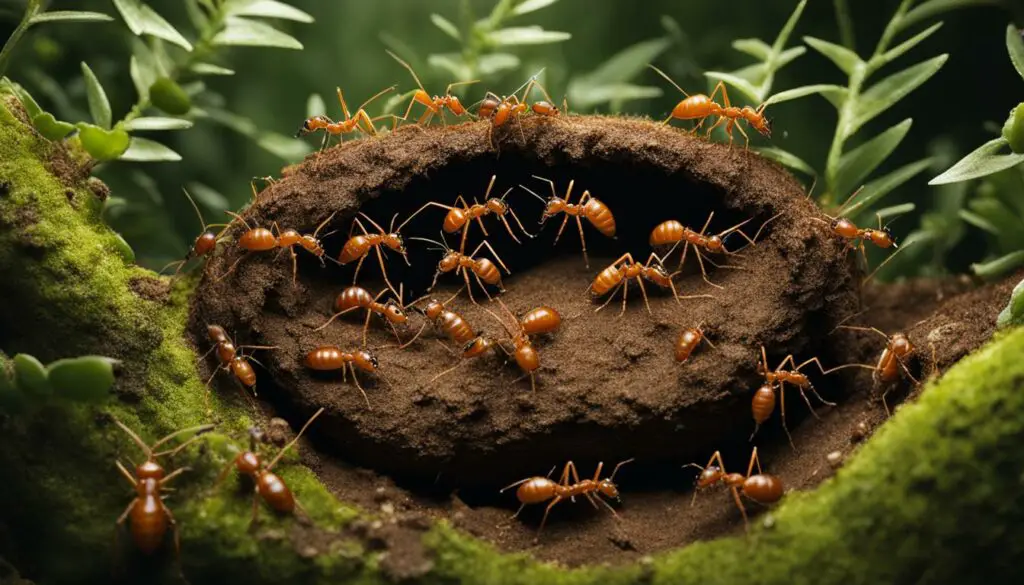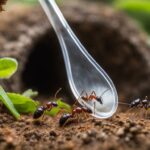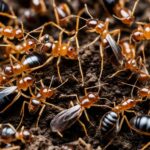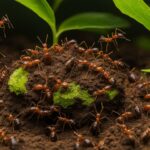Owning and caring for a pet ant colony can be a fascinating and rewarding experience. In this comprehensive queen ant care guide, I will provide you with all the tips and information you need to ensure the health and well-being of your ant colony. From choosing the right ants to providing them with the proper housing and nutrition, this guide covers it all. Get ready to become an expert in ant care!
Key Takeaways:
- Learn how to choose the best ant species for your ant farm
- Set up a suitable formicarium and outworld for your queen ant and her colony
- Feeding your ant colony with the right balance of sugars and proteins is essential for their health
- Proper hydration is important – provide water sources for your ant colony
- Take precautions to prevent ant escapes and ensure the security of your ant farm
Where to Get Ants for Your Ant Farm
If you’re wondering where to get ants to start your ant farm, there are a few options available to you. You can purchase ants from a reputable ant supplier or capture them yourself from the wild. However, it’s important to note that mixing different species of ants or even ants from different colonies can lead to aggression and even death. It’s best to stick to one species or colony in your ant farm to promote a peaceful and thriving colony.
When buying ants, it’s crucial to choose a trusted ant supplier. Look for suppliers that specialize in ant colonies and provide healthy and well-cared-for ants. They should be able to provide you with detailed information about the species they offer, including their behavior, habitat requirements, and compatibility with other ant species. It’s also beneficial to read reviews and seek recommendations from experienced ant keepers to ensure you’re getting quality ants.
If you prefer capturing ants from the wild, make sure to research local ant species in your area and their specific nesting habits. You can set up bait traps using sweet foods like sugar water or honey to attract ants. Once you’ve captured ants, it’s important to transfer them to your ant farm as soon as possible to minimize stress and ensure their survival. Remember to conduct thorough research on the species you’re capturing, as different ant species have different care requirements.
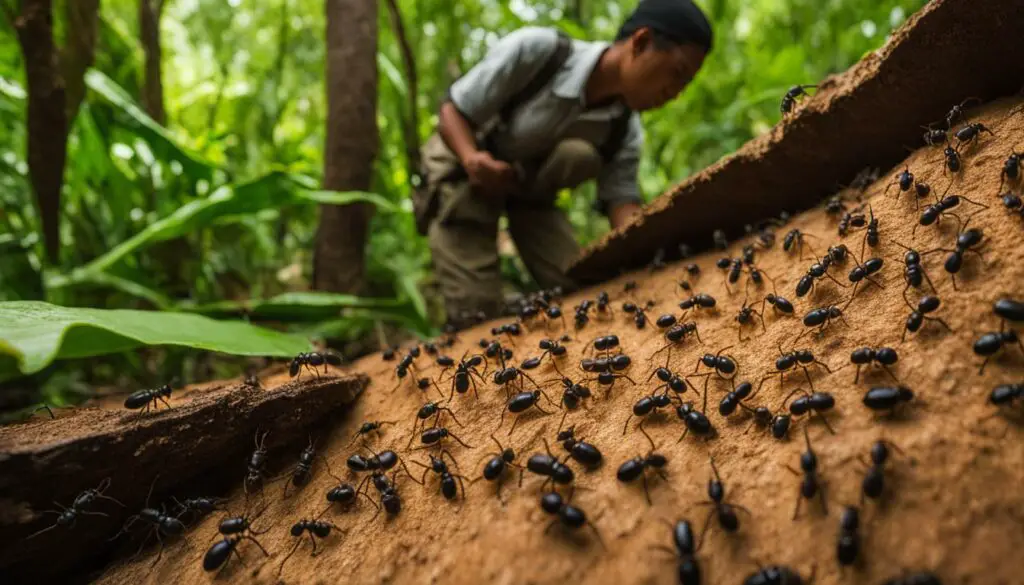
In conclusion, whether you choose to buy ants from a supplier or capture them from the wild, it’s important to prioritize the health and compatibility of the ants for your ant farm. By taking the time to research and choose the right ants, you can create a harmonious and thriving ant colony that will bring you joy and fascination for years to come.
Choosing the Best Ant Species for Your Ant Farm
When it comes to selecting the best ant species for your ant farm, there are a wide variety of options to consider. Different ant species have unique traits and behaviors that can make them more suitable for specific setups or preferences. In this section, I will provide an overview of some popular ant keeping species and their characteristics to help you make an informed decision for your ant farm.
Popular Ant Pets
Here are some of the most popular ant species kept as pets:
- Camponotus: These ants, also known as carpenter ants, are large and easy to observe. They are active during the day and tend to be relatively docile.
- Lasius: Lasius ants are small and suitable for smaller setups. They are known for their fast growth and adaptability.
- Messor: Messor ants are fascinating species that have a unique behavior of storing and consuming seeds. They are great for observing their seed gathering and storage activities.
- Pheidole: Pheidole ants are known for their division of labor, with specialized worker castes. They can be highly active and interesting to observe.
- Tetramorium: Tetramorium ants, also called pavement ants, are robust and hardy species. They are adaptable and can thrive in a variety of conditions.
It’s important to note that each ant species may have specific care requirements and preferences for their living conditions. Before choosing the species for your ant farm, I recommend researching their individual needs and ensuring you can provide the appropriate environment for their well-being.
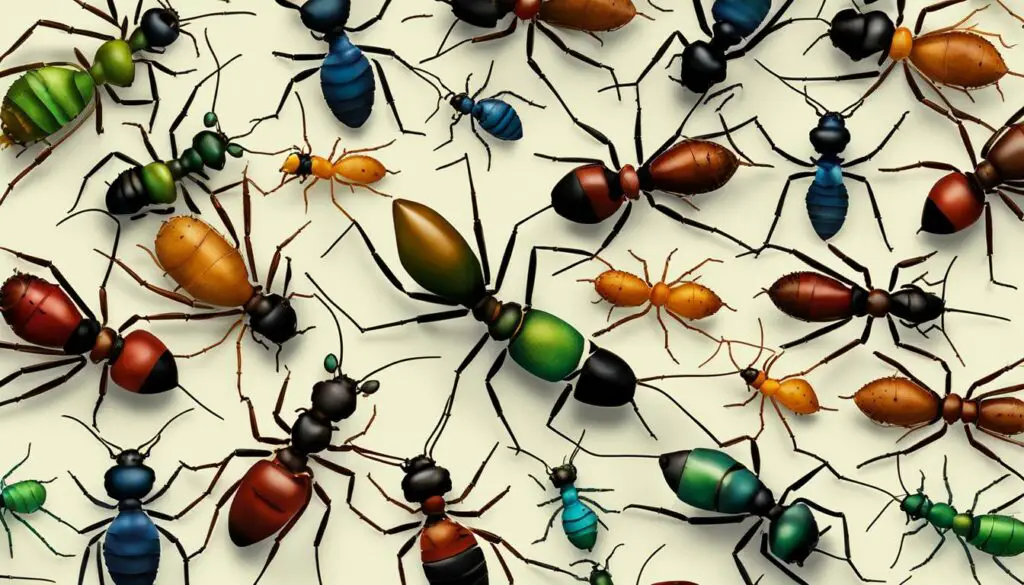
With a diverse range of ant species to choose from, you can select the ones that best match your interests and preferences as an ant keeper. Whether you prefer observing their foraging behavior, seed collecting activities, or efficient division of labor, there is an ant species out there that will captivate you. Remember to provide the necessary care and suitable living conditions for your chosen ant species to ensure a thriving and healthy ant farm.
Setting Up the Ant Farm: Formicarium and Outworld
When it comes to setting up your ant farm, having the right equipment is essential. The formicarium is the area where your ant colony will nest, and it should be equipped with chambers and tunnels to accommodate the queen, workers, and brood. You can find various types of formicariums available for purchase, such as the popular Omni Nests™ and Hybrid Nests™ from AntsCanada. These formicariums are designed to provide the optimal living conditions for your ants, with easy access to food and moisture.
Additionally, you’ll need an outworld, which serves as the ants’ foraging area outside the nest. The outworld provides space for your ants to explore and find food, mimicking their natural environment. It’s important to connect the formicarium and outworld with vinyl tubing to allow the ants to navigate between the two areas. This ensures a seamless transition for the ants and allows them to easily access food and water in the outworld.
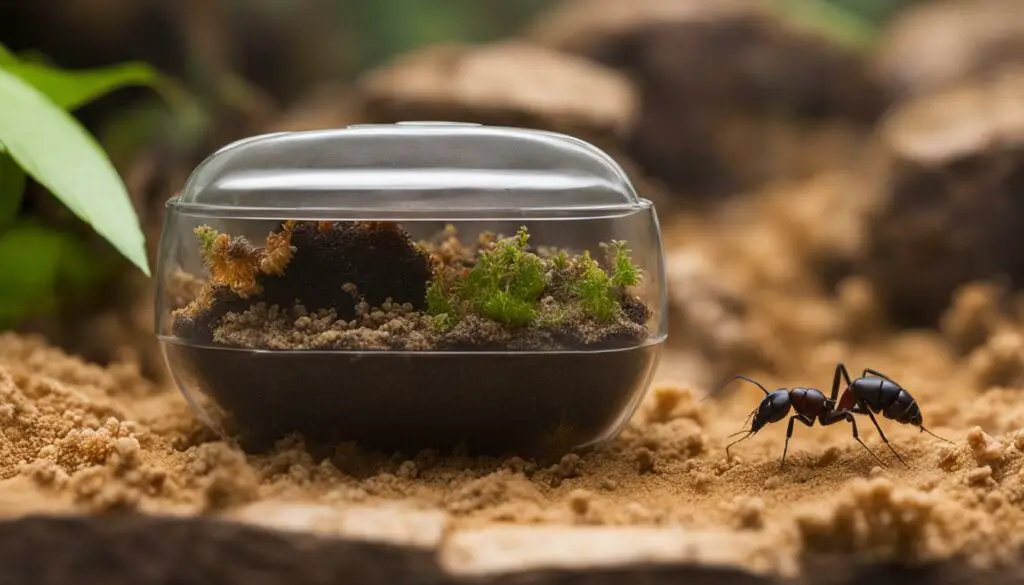
Choosing the Right Formicarium
When selecting a formicarium for your ant farm, there are a few factors to consider. Firstly, the size of the formicarium should be appropriate for the number of ants you plan to keep. It’s important to provide enough space for the colony to grow, but not so much space that it becomes difficult for the ants to maintain and defend their nest. Additionally, consider the material of the formicarium. Some ants prefer natural materials like soil or sand, while others may thrive in an artificial setup with clear acrylic or glass walls.
| Formicarium Type | Pros | Cons |
|---|---|---|
| Natural Soil or Sand Formicarium |
|
|
| Acrylic or Glass Formicarium |
|
|
Choosing the right formicarium is crucial for the success of your ant farm. Consider the size, material, and specific needs of your ant species when making your selection. Providing a suitable and comfortable nesting environment will ensure the health and happiness of your ant colony.
Feeding Your Ant Colony: Sugars and Proteins
Proper nutrition is crucial for the health and well-being of your ant colony. Ants require a mixture of sugars and proteins to thrive. You can feed them a variety of foods, including bread or cake crumbs, pieces of fruit, and sugar water. The adult workers primarily eat sugars, while the brood relies on protein-rich foods. Providing your ants with insects like crickets, flies, mealworms, or wax worms is essential to ensure they receive sufficient protein for reproduction and colony growth.
When it comes to sugars, offering a sugar water solution is a convenient and effective way to meet the ants’ dietary needs. Mix 7 parts of tap water with 1 part of sugar or honey to create a sugar water solution. Place this mixture in the lid of a soda bottle inside the ant farm, ensuring easy access for the ants.
For protein, you can provide fresh or frozen insects. These can be offered directly to the ants or placed in a small dish within the ant farm. Remember to remove any uneaten food promptly to maintain cleanliness and prevent mold or pest issues. It is recommended to provide a balanced diet of both sugars and proteins to support the overall health and development of your ant colony.
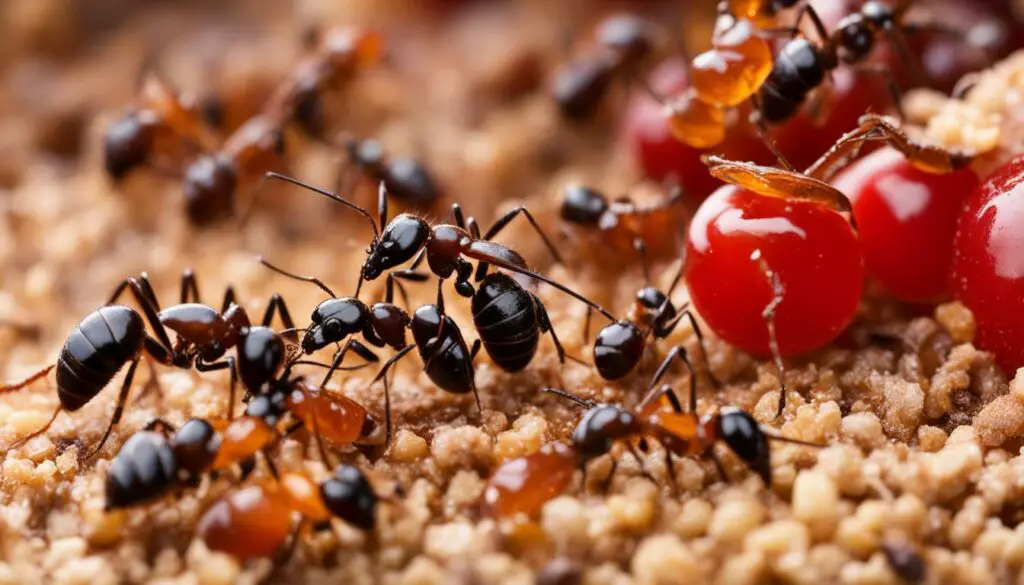
Table: Foods for Ant Colony Nutrition
| Type of Food | Serving Suggestion |
|---|---|
| Bread or cake crumbs | Place small pieces of bread or cake crumbs inside the ant farm. |
| Pieces of fruit | Offer small slices or chunks of fruit, such as apples or bananas, in the ant farm. |
| Sugar water | Mix 7 parts of water with 1 part of sugar or honey and place it in the ant farm. |
| Insects (crickets, flies, mealworms, wax worms) | Provide live or frozen insects directly to the ants or in a separate dish within the ant farm. |
By offering a varied and balanced diet, you can ensure that your ant colony receives the necessary nutrients to thrive and maintain their overall health.
Providing Water for Your Ant Colony
Water is essential for the hydration and survival of your ant colony. Proper hydration ensures the health and well-being of your ants, so it’s important to provide them with a steady supply of clean water. There are a few ways you can ensure your ants have access to water in their habitat.
One method is to offer a mixture of sugar and water, known as sugar water. This provides a source of hydration and energy for the ants. To make sugar water, mix 7 parts of tap water with 1 part of sugar or honey. Place the mixture in the lid of a soda bottle inside the ant farm. Make sure to regularly replenish the sugar water to ensure your ants always have access to fresh hydration.
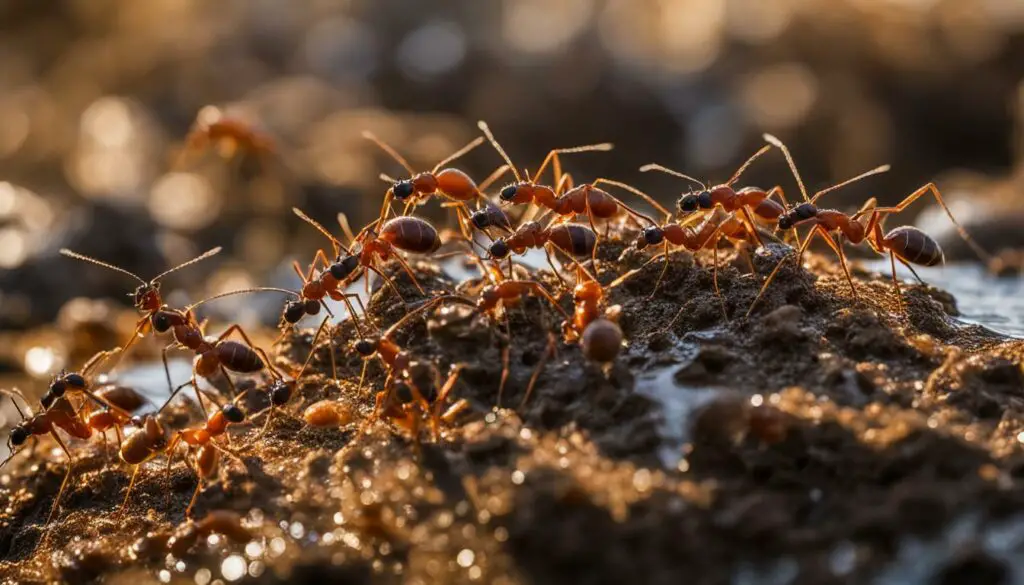
Another way to provide water for your ant colony is by lightly misting the interior walls of the formicarium with water using a spray bottle. This creates a humid environment and adds moisture to the habitat, especially beneficial in warmer climates. Be careful not to over-mist the habitat, as excessive moisture can lead to mold growth and other issues.
Remember to monitor the water sources in your ant farm regularly and replenish them as needed. Clean and fresh water is essential for the health and well-being of your ant colony, ensuring they have the hydration they require to thrive.
Preventing Escapes: Keeping Your Ants Inside
When it comes to keeping an ant farm, one of the biggest concerns for ant keepers is preventing escapes. Fortunately, there are several effective methods you can employ to keep your ants safely contained within their habitat. Here are some tips to help you ensure that your ant colony stays inside their designated space.
Using Ant Deterrents
One of the most common and effective ways to prevent ants from escaping is by using ant deterrents. Applying substances like vaseline or baby powder to the rims of the outworld door and joints can create a barrier that ants find difficult to cross. Another option is to use products like paraffin oil or Fluon, which create a slippery surface that ants cannot grip onto. These deterrents can be applied strategically to areas where ants are most likely to attempt an escape, providing an extra layer of security for your ant farm.
Frequent Checks and Maintenance
Regularly checking your formicarium and outworld for any cracks, gaps, or loose connections is crucial to preventing escapes. Conduct frequent inspections to ensure that the housing is intact and there are no potential escape routes for the ants. It’s important to address any issues immediately by sealing gaps or repairing damages. By staying vigilant and proactive in your maintenance routine, you can minimize the risk of ants finding a way to escape.
Monitoring Ant Behavior
Observing the behavior of your ants can provide valuable insights into their escape attempts. Pay close attention to any signs of restlessness or agitation among the ants, as this could indicate their desire to find an exit. Addressing any potential escape attempts promptly can prevent larger-scale escapes and help maintain the safety and containment of your ant colony.
By implementing these preventative measures and staying proactive in your ant farm maintenance, you can ensure that your ants stay safely contained within their designated habitat. With a secure environment, you can enjoy the fascinating world of ant keeping without the worry of escapes.
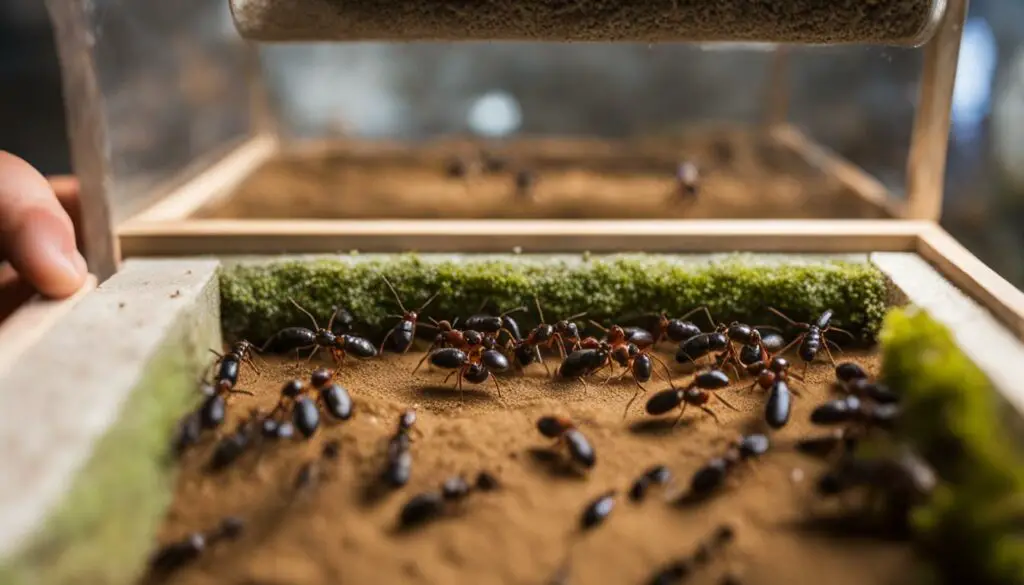
| Deterrent Method | Effectiveness | Difficulty |
|---|---|---|
| Vaseline or Baby Powder | High | Low |
| Paraffin Oil | Medium | Medium |
| Fluon | High | Medium |
Queen Ant Mating and Nuptial Flights
Queen ants play a crucial role in the growth and expansion of an ant colony through mating flights, also known as nuptial flights. This natural phenomenon occurs when young, winged queens and males leave the nest to mate and establish new colonies. While in captivity, queen ants may not experience mass nuptial flights as they would in the wild due to constant environmental conditions. Nevertheless, it is important to be aware of signs of flight readiness in winged queens, known as alates, and provide them with the opportunity to fly and mate outside. This should only be done with native ants to avoid introducing non-native species into the environment.
“Mating flights are a remarkable and essential part of an ant colony’s life cycle. Allowing your queens to engage in these flights not only promotes their reproductive success but also ensures genetic diversity and the potential for future colony growth and expansion.”
To facilitate nuptial flights, it is advisable to move the entire setup outside when alates start showing signs of flight. This allows them to fully engage in their natural mating behavior. However, it is crucial to exercise caution and monitor the situation closely to prevent escapes or the introduction of unwanted pests into the environment. The presence of multiple queens in an ant farm may increase the likelihood of nuptial flights, as queens may release pheromones that signal readiness to mate.
Understanding and facilitating queen ant mating and nuptial flights is an important aspect of ant keeping. By observing and providing suitable conditions for these crucial events, ant keepers can contribute to the successful reproduction and growth of their ant colonies.
Queen Ant Mating Event
The table below summarizes the key points to consider regarding queen ant mating:
| Aspect | Consideration |
|---|---|
| Timing | Observe alates for signs of flight readiness and move the setup outside during the appropriate season. |
| Location | Perform nuptial flights in a controlled environment, preferably outdoors, to allow mating to occur naturally. |
| Species | Ensure that the queens engaging in nuptial flights are of native species to avoid introducing non-native ants into the environment. |
| Monitoring | Continuously observe the behavior of the alates during the flight and mating process to ensure their safety and prevent escapes. |
By following these guidelines, ant keepers can support the reproductive success of their queen ants and contribute to the overall health and vitality of their ant colonies.
Managing Colony Size and Growth
As an ant keeper, one of the important tasks is to manage the size and growth of your ant colony. Controlling the population ensures a healthy and sustainable colony. To limit the growth of your ant colony, it is essential to control their food supply. By limiting protein-rich foods, you can slow down the breeding process and maintain a desired colony size. Additionally, lowering the temperature slightly can also help regulate the growth rate of the colony.
By monitoring your ant colony closely, you can adjust their environment and nutrition as needed. It’s important to strike a balance between providing enough resources for their well-being and preventing overpopulation, which can lead to overcrowding and potential health issues. Regular observation and adjustment will help ensure a healthy and thriving ant colony.
When it comes to managing colony size and growth, it is crucial to consider the specific requirements of the ant species you are keeping. Different ant species have varying growth rates and population dynamics. Researching and understanding the biology and behavior of your chosen ant species will guide you in implementing effective strategies for managing colony size and growth. Remember, a healthy and sustainable ant colony is the key to a successful ant keeping experience.
| Methods for Managing Colony Size and Growth | Effectiveness |
|---|---|
| Limiting food supply | High |
| Lowering temperature slightly | Moderate |
| Regular monitoring and adjustments | High |
Caring for Multiple Queens in One Nest
Some ant species have unique colony structures that allow for the coexistence of multiple queens. This phenomenon is known as polygyny or pleometrosis, where two or more queens live together peacefully in a single nest and raise their young together until the first workers emerge. However, it’s important to note that some queen ants may become aggressive towards each other or the workers may kill extraneous queens. As a pet ant keeper, you can choose to keep multiple queens in a large setup or separate nest chambers and monitor their behavior closely for any signs of conflict.
Managing a multiple queen ant colony requires careful observation and intervention if necessary. It’s important to provide enough space and resources for each queen to thrive. This can be done by ensuring there are ample nesting areas, food sources, and moisture for the queens and their brood. Regular checks and monitoring of the colony’s behavior are also crucial to detect any signs of aggression or stress among the queens.
If conflicts arise between the queens or between the queens and workers, it may be necessary to separate them into individual nests to prevent further harm. This can be done by carefully transferring each queen and her brood into separate formicariums or nest chambers. It’s essential to handle the queens with care and minimize stress during this process to ensure their well-being.
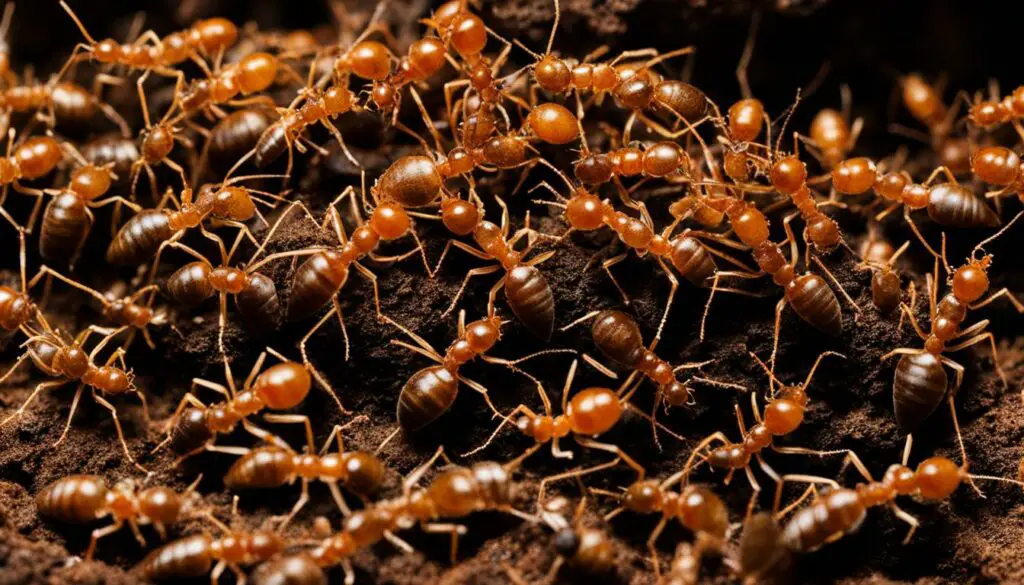
Benefits and Considerations of Multiple Queen Ant Colonies
Keeping multiple queens in one nest can have several benefits. It can increase the reproductive potential of the colony, as each queen is capable of laying eggs and producing workers. This can lead to a larger and more robust colony over time. Multiple queen ant colonies can also exhibit greater resilience and adaptability, as the presence of multiple queens can provide redundancy in case of queen mortality or other challenges.
However, it’s important to carefully consider the specific species of ants you are keeping and their natural behavior. Not all ant species are suitable for multiple queen colonies, and the success of a multiple queen setup can vary depending on the species’ social structure and compatibility. Some ant species are naturally monogynous (having only one queen per colony), and attempting to introduce multiple queens may result in conflicts or failure.
| Benefits of Multiple Queen Colonies | Considerations for Multiple Queen Colonies |
|---|---|
|
|
Overall, caring for multiple queens in one nest can be a fascinating and rewarding aspect of ant keeping. It provides a unique opportunity to observe the complex social dynamics and cooperation within ant colonies. By understanding the specific needs and behaviors of your ant species, you can create a suitable environment for multiple queens to coexist harmoniously and contribute to the growth and success of the colony.
The Importance of Nest Size and Space
When caring for a queen ant and her colony, providing the right nest size and space is crucial for their health and well-being. The size of the nest plays a significant role in colony growth and expansion, and it’s essential to ensure that the ants have adequate space to thrive.
A small nest is recommended for starting an ant colony as it helps prevent excess garbage buildup and mold outbreaks. As the colony grows, they will naturally expand into larger nests. Monitoring their nesting space and providing appropriate sizes is necessary to avoid overcrowding or wasted space that can lead to health issues for the colony.
To better understand the optimal nest dimensions for different ant species, I have compiled the following table:
| Ant Species | Optimal Nest Size |
|---|---|
| Lasius niger | Small to medium-sized nest |
| Messor barbarus | Medium to large-sized nest |
| Camponotus vagus | Large-sized nest |
It’s important to note that the optimal nest size may vary depending on the species and colony size. Researching and understanding the specific needs of your ant species will help ensure that they have the right amount of space to thrive.
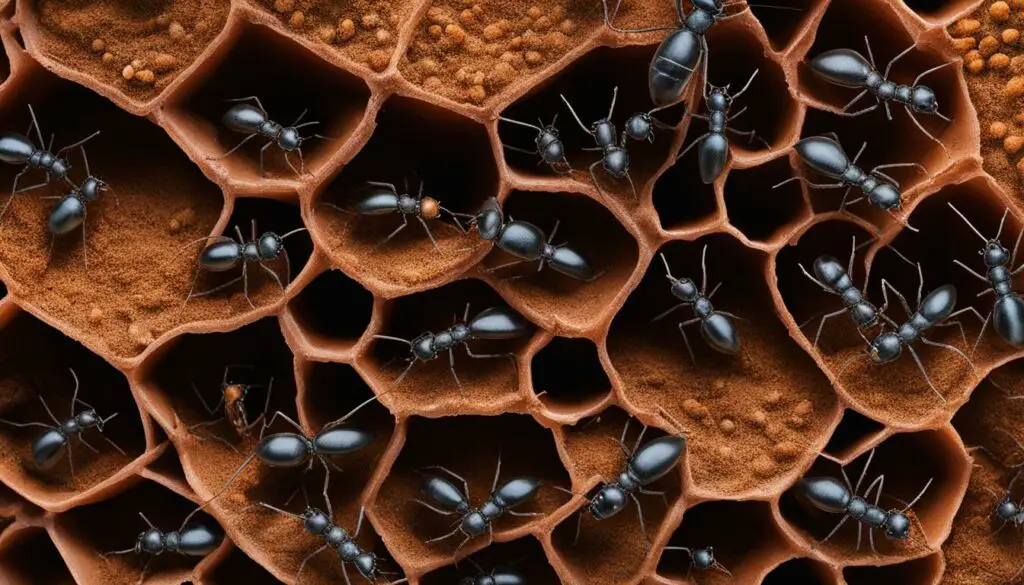
Benefits of Providing Adequate Nest Size and Space
- Prevents overcrowding and stress among the ants
- Reduces the risk of disease outbreaks and mold formation
- Allows for proper brood development and colony expansion
- Facilitates the natural behavior and foraging activities of the ants
“Providing the right nest size and space for your ant colony is essential for their overall health and success. It allows them to exhibit natural behaviors and ensures that they have enough room to grow and expand. By understanding the specific needs of your ant species and providing suitable nest dimensions, you are setting your colony up for a thriving and sustainable future.”
Moving the Colony to a New Nest
As your ant colony grows, there may come a time when they outgrow their current nest and require a larger space. Moving the colony to a new nest can be a delicate process, but with the right strategies, it can be accomplished successfully. One effective method is to connect the old and new nests and allow the ants to explore and eventually move to the new location. Changes in heat, moisture, or light can also encourage the ants to relocate. It’s crucial to carefully observe and monitor the ants’ behavior during the transition to ensure a smooth and successful relocation.
Moving the colony to a new nest not only provides the ants with more space but also promotes their overall well-being and allows for continued growth. When choosing a new nest, consider the size and design that will best suit the needs of your growing colony. It’s important to provide enough chambers and tunnels for the queen, workers, and brood to thrive. Additionally, ensure that the new nest is connected to an outworld to allow for foraging and exploration.
During the relocation process, it’s essential to minimize stress and disturbances to the ants. Keep the environment calm and avoid sudden movements or loud noises that may disrupt their natural behavior. As the ants start to settle into their new nest, closely monitor their activity to ensure they adjust well to the new surroundings. Provide them with ample food and water to support their transition and help them establish a strong and healthy colony in their new home.
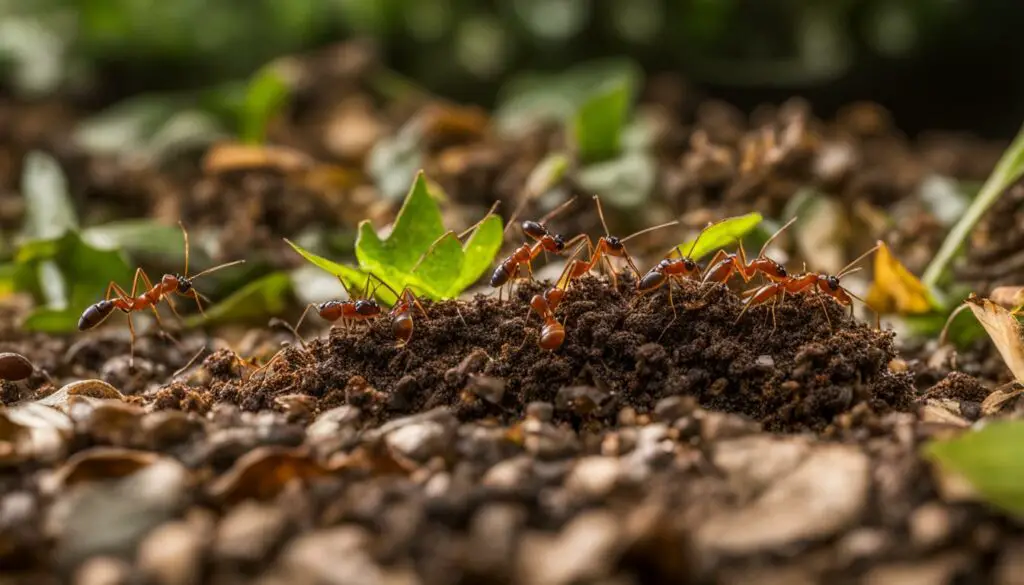
| Step | Description |
|---|---|
| 1 | Prepare the new nest: Ensure the new nest has enough space and suitable conditions for your growing colony. Connect the old and new nests using tubing or other appropriate methods. |
| 2 | Encourage exploration: Introduce the ants to the new nest by allowing them to freely move between the old and new nests. This can be achieved by connecting the nests and providing access points. |
| 3 | Monitor behavior: Observe the ants’ behavior closely during the transition period. Pay attention to their activity levels, foraging patterns, and overall well-being. |
| 4 | Provide food and water: Ensure the ants have access to sufficient food and water during the relocation process. This will help support their energy levels and aid in the establishment of the new colony. |
| 5 | Monitor and adjust: Continually monitor the ants’ progress in the new nest and make any necessary adjustments to ensure their continued growth and well-being. |
Ant Colony Hibernation
The winter months bring about a period of hibernation for ant colonies in temperate regions. Hibernation serves as a time for the ants to rest and conserve energy during the colder weather. To prepare your ant colony for hibernation, it is essential to provide them with a suitable location where the temperature remains between 5-12°C. This ensures that the ants are not exposed to extreme cold, which could be detrimental to their survival.
Hibernation typically takes place from late October to late March, although a shorter hibernation period from early December to late February can also be considered. It is crucial to monitor the temperature and adjust their habitat as needed to maintain the ideal conditions throughout this period. Proper hydration and nutrition are also vital during hibernation to support the ants’ health and sustenance.
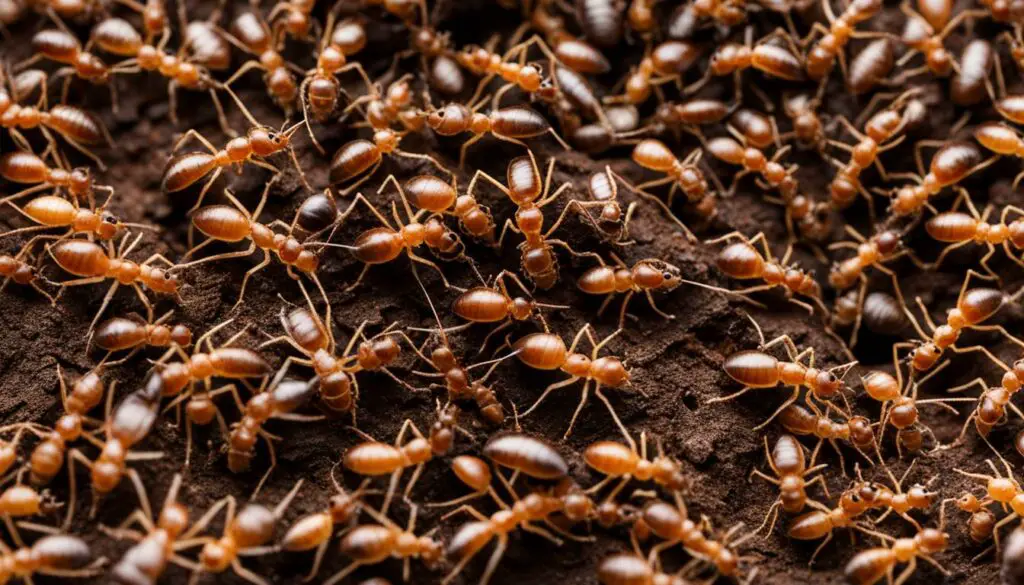
During hibernation, the ants’ activity levels significantly decrease. They may appear sluggish or inactive, as they conserve energy and minimize movement. It is important not to disturb the ants during this time and provide them with a quiet and undisturbed environment. Regularly check on their hydration sources and replenish them as needed, ensuring that the ants have access to clean water.
As the winter months come to an end and temperatures begin to rise, the ants will gradually emerge from hibernation and resume their usual activities. It is important to observe them closely during this transitional period and ensure that they have enough resources available as they transition back to their active state. With proper care and attention, your ant colony can successfully navigate through the hibernation period and thrive in the coming seasons.
Ant Escape Prevention Tips
Keeping your ants securely contained within their ant farm is essential for maintaining a successful and hassle-free ant-keeping experience. Here are some key tips to prevent ant escapes:
- Regular Checks: Conduct frequent inspections of your ant farm to identify any cracks, gaps, or loose connections that may be potential escape routes for your ants. Address these issues promptly to ensure the security of your ant colony.
- Securing the Farm: Apply a thin layer of vaseline or baby powder along the edges of the formicarium and outworld. This creates a physical barrier that ants find difficult to cross, discouraging escape attempts.
- Mind the Connections: Double-check the connections between the formicarium and outworld, ensuring they are tightly sealed. Loose connections can provide ants with an opportunity to venture outside the designated areas.
- Monitor Ant Behavior: Pay close attention to the behavior of your ant colony. Any signs of restlessness or frequent attempts to escape may indicate that their current setup requires adjustments. Remain vigilant and take proactive measures to address these concerns.
By implementing these ant escape prevention tips, you can create a secure and stable environment for your ant colony, allowing you to enjoy the fascinating world of ant keeping without the worry of potential escapes.
Expert Quote
“Ant escape prevention is crucial for maintaining a controlled and safe ant-keeping environment. Regular checks and proactive measures can go a long way in ensuring the security of your ant colony.”
– Dr. Ant Expert
Remember, the key to successful ant escape prevention is diligence and attention to detail. By regularly inspecting and securing your ant farm, you can provide a safe and stable habitat for your ants to thrive in.
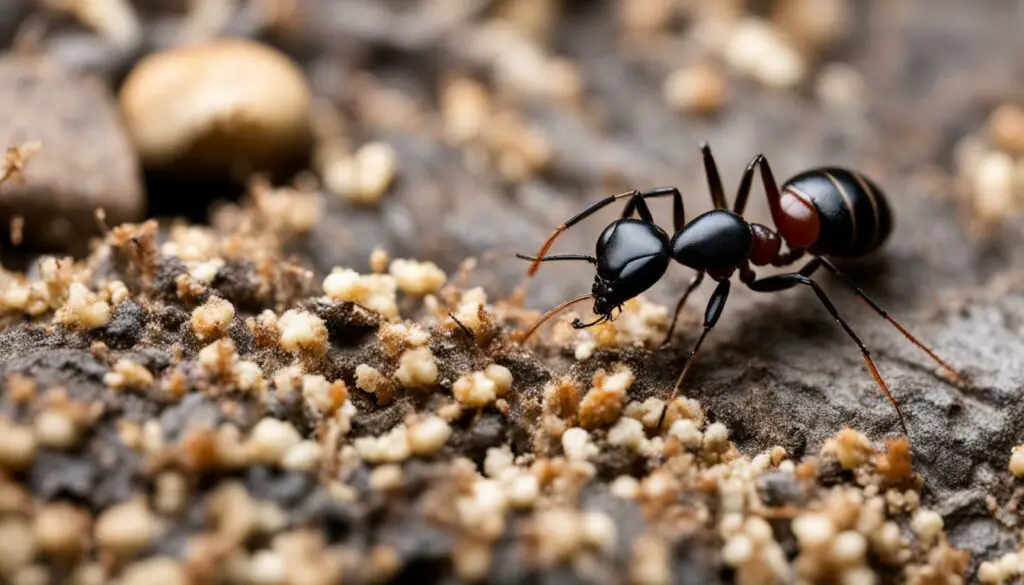
Conclusion
In this complete Queen Ant Care Guide, I have provided you with all the necessary information and tips to ensure the health and well-being of your ant colony. By following these guidelines, you can become an expert in ant care and create a thriving ant farm.
From choosing the right ants and setting up their housing to providing the proper nutrition and preventing escapes, every aspect of ant colony care has been covered. It’s crucial to choose the best ant species for your ant farm and create an appropriate environment with a formicarium and outworld.
Feeding your ant colony with a balanced diet of sugars and proteins is essential, and supplying them with clean water is crucial for their hydration. By managing colony size and growth, as well as understanding the unique behaviors of multiple queens in one nest, you can create a harmonious and healthy ant colony.
Remember to monitor the nesting space, relocate the colony when needed, and prepare them for hibernation if you live in a temperate region. Finally, take precautions to prevent escapes and regularly check the security of your ant farm.
With proper care and dedication, you can embark on an exciting journey into the world of ant keeping and witness the wonders of these incredible social insects. Enjoy the rewarding experience of caring for a queen ant and her colony!
FAQ
Where can I get ants for my ant farm?
You can purchase ants from a reputable ant supplier or catch them yourself from the wild. However, it’s important to note that mixing different species of ants or ants from different colonies can lead to aggression and even death, so it’s best to stick to one species or colony in your ant farm.
How do I choose the best ant species for my ant farm?
Almost all species of ants can be successfully kept as pets with the right care and conditions. In the AntsCanada Ultimate Ant Keeping Handbook™ Ebook, you can find a list of the most common ant species kept as pets and specific details about their preferred living conditions. Make sure to research their individual care requirements before getting them for your ant farm.
How do I set up the ant farm with a formicarium and outworld?
A formicarium is the area where your ant colony will nest, and it should be equipped with chambers and tunnels for the queen, workers, and brood. You can find various types of formicariums available for purchase. You’ll also need an outworld, which simulates the ants’ foraging area. It’s important to connect the formicarium and outworld with vinyl tubing to allow the ants to navigate between the two areas.
What should I feed my ant colony?
Ants require a mixture of sugars and proteins to thrive. You can feed them a variety of foods, including bread or cake crumbs, pieces of fruit, and sugar water. The adult workers primarily eat sugars, while the brood relies on protein-rich foods. Providing insects like crickets, flies, mealworms, or wax worms is essential to ensure they receive sufficient protein for reproduction and colony growth.
How do I prevent ants from escaping my ant farm?
You can prevent escapes by applying substances like vaseline or baby powder to the edges of the outworld door and joints. Another option is using paraffin oil or a product called Fluon, which creates a slippery surface that ants cannot grip onto. It’s important to choose a safe and effective method to prevent escapes while ensuring the well-being and safety of your ant colony.
How do queen ants mate and establish new colonies?
Mating flights, also known as nuptial flights, occur when young, winged queens and males leave the nest to mate and establish new colonies. In captivity, queen ants may not undergo mass nuptial flights as they would in the wild, but if you notice alates (winged males and queens) showing signs of flight, it’s best to move the entire setup outside to allow them to fly and mate.
How can I manage the size and growth of my ant colony?
You can limit the growth of your ant colony by limiting their food supply, especially protein-rich foods. Lowering the temperature slightly can also slow down the breeding process. It’s essential to monitor your ant colony and adjust their environment and nutrition as needed to ensure a healthy and sustainable population.
Can I keep multiple queens in one ant nest?
Some ant species have unique colony structures that allow for the coexistence of multiple queens. This phenomenon is known as polygyny or pleometrosis. However, it’s important to closely monitor their behavior for any signs of conflict, as some queen ants may become aggressive towards each other or the workers may kill extraneous queens.
How important is the size of the nest for an ant colony?
The size of the nest plays a crucial role in the health and growth of an ant colony. It’s important to provide the right amount of space based on the size of the colony. Starting with a small nest is recommended to prevent excess garbage buildup and mold outbreaks. As the colony grows, they will naturally expand into larger nests.
How do I move my ant colony to a new nest?
Moving the colony to a new nest can be accomplished by connecting the old and new nests and waiting for the ants to explore and eventually move to the new location. Changes in heat, moisture, or light can also encourage the ants to move. It’s important to carefully observe and monitor the ants’ behavior during the transition to ensure a successful relocation.
How do I prepare my ant colony for hibernation?
To prepare your ant colony for hibernation, ensure they have access to a suitable location where the temperature remains between 5-12°C. The ideal time for hibernation is usually from late October to late March. Proper hydration and nutrition are crucial for the ants’ health and survival during hibernation.
How can I prevent ants from escaping my ant farm?
To prevent escapes, regularly check the formicarium and outworld for any cracks, gaps, or loose connections. Use deterrents like vaseline or baby powder on the edges of the formicarium and outworld to create a barrier for the ants. Monitor the general behavior of the ants to detect any signs of attempts to escape and address them promptly.

